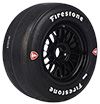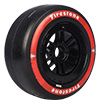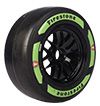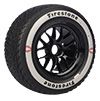Intro
Get Ready to HIT THE TRACK
NTT INDYCAR® SERIES
Now in its 25th consecutive season as the exclusive tire supplier of the NTT INDYCAR SERIES, Firestone is a key innovation and marketing partner for the most versatile racing series in the world. The Firestone Race Tire Engineering team and nearly 60 expert tire builders will deliver approximately 32,000 Firestone Firehawk race tires for the 2024 NTT INDYCAR SERIES season, including more than 5,000 tires for use in practice, qualifying and competition for the Indianapolis 500® alone. In all, Firestone Racing will design, develop, and deliver more than 60 different race tire specifications to meet the extensive and varying demands of the 16 unique oval, road, and street course circuits across the 2024 NTT INDYCAR SERIES schedule.
Learn more about the NTT INDYCAR SERIES
INDY NXT By Firestone
Firestone further demonstrated its continued commitment to the future of NTT INDYCAR SERIES racing by expanding its partnership to be presenting sponsor and exclusive tire supplier of the top-tier development series, INDY NXT by Firestone beginning with the 2023 season. While involved with previous iterations of the ladder series since the early 1990s, this season Firestone will produce more than 5,200 tires with 16 different specifications to support the series and help develop the next generation of drivers.
Heritage
FIRESTONE & THE NTT INDYCAR® SERIES
Driven by the pioneering spirit of its founder, Harvey Firestone, the Firestone brand’s storied heritage in racing dates back to 1911 when Ray Harroun drove his Firestone-equipped Marmon Wasp to the win at the inaugural Indianapolis 500© Mile Race. Today, Firestone continues to use world-class racing to demonstrate its uncompromised durability and dependability. The brand has been the exclusive tire supplier to the NTT INDYCAR SERIES and the Indy 500 for 25 straight years. Additionally, 2024 will mark the 75th time that Firestone tires will drive to a win at "The Greatest Spectacle in Racing" – more than twice as many Indy 500 wins as all other tire manufacturers combined.
Cars
Cars
NTT INDYCAR® SERIES cars are mechanical and aerodynamic works of art, capable of astounding performance and speed. Each car is configured specifically for the type of track it will drive on, and everything is adjustable, including the high-performance Firestone Firehawk tires. Fine-tuning the car is as integral to success as the driver's race craft.
- 1,600 LBS LIGHT & AGILE
- 12K RPM HIGH REV
- 700 EST. HP RAW POWER
- 230+ MPH AT INDY 500
- 5,000 LBS DOWNFORCE
Tires
Tires
NTT INDYCAR® SERIES TIRES
Firestone Firehawk race tires are specifically engineered for the type of course they'll be used on. Oval tracks use just one type of tire, while road and street tracks can use all three types - primary, alternates (red or green), and rain.
PRIMARY BLACK The black sidewall primary Firestone race tires offer a competitive balance between speed, cornering, and durability. Firehawk primary tires are used on all three types of track.
ALTERNATE RED Visually differentiated by red sidewalls, Firestone alternate tires have a softer compound than primary tires, allowing for faster speeds and better cornering, but quicker wear. Red alternate tires are used on permanent road tracks only.
ALTERNATE GREEN Starting in 2023, Firestone Firehawk alternate green race tires have been provided for all temporary street course races and feature natural rubber extracted from guayule shrubs in their sidewall construction. The guayule desert shrubs are grown at the company's guayule research facilities in Arizona, and these unique tires are visually differentiated by green sidewalls.
RAIN These grey sidewall Firestone race tires were developed for wet conditions and use a grooved tread pattern that improves grip, control and helps prevent hydroplaning. Rain tires are used on road and street courses only, as the NTT INDYCAR SERIES does not run oval races if conditions are wet.
All Firestone Firehawk race tires are manufactured at the Bridgestone Advanced Tire Production Center in Akron, Ohio, which opened in 2022 and was certified by the International Sustainability and Carbon Certification (ISCC) system for its transparency and traceability of sustainable raw materials. It’s here that the Firestone Race Tire Engineering team works side-by-side with passenger tire engineers at the nearby Bridgestone Americas Technology Center to leverage lessons from racing to improve the products featured across the Bridgestone and Firestone passenger tire lines.
INDY NXT BY FIRESTONE TIRES:
DRY INDY NXT race cars use Firestone Firehawk race tires that are specifically engineered for the type of car and the type of course they'll compete on. INDY NXT races do not have pitstops and only require one type of (dry) tire.
RAIN Firestone Firehawk INDY NXT rain tires were developed for wet conditions and use a grooved tread pattern that improves grip, control and helps prevent hydroplaning. Rain tires are used on road and street courses only, as INDY NXT by Firestone does not run oval races if conditions are wet.
Race Circuits
Race Circuits
The NTT INDYCAR SERIES and INDY NXT by Firestone compete on three types of tracks throughout the season: street, road, and oval.
STREET A temporary circuit made up of closed-off public streets, roads, and even airport runways in a city or town with a tight track, wall, and no runoff areas. Check out the street action at the Firestone Grand Prix of St. Petersburg , Acura Grand Prix of Long Beach, Chevrolet Detroit Grand Prix and Honda INDY Toronto. INDY NXT by Firestone races at all street events except Toronto.
ROAD This circuit is similar to street tracks but takes place in a dedicated racing facility rather than existing public streets. See Barber Motorsports Park , Road America and Mid-Ohio Sportscar Course as examples of permanent road courses.
OVAL A circuit with banked turns and unique variances in shape, oval tracks feature the highest speeds due to their wide-open nature. The Indianapolis 500® is by far the most famous oval race in motorsports. Milwaukee Mile and Nashville Superspeedway have been added to the 2024 NTT INDYCAR® SERIES schedule.
INDY NXT will race on the same oval tracks with the exception of Indianapolis Motor Speedway’s oval configuration.
Qualifying
Qualifying
A driver's qualification run determines their starting order in a race. Depending on the type of race circuit, qualifying can work in different ways. More qualifying information is available at INDYCAR.com.
OVAL Qualification is determined by the combined time for two consecutive timed laps (except Indianapolis 500.)
STREET & ROAD Qualification is broken into segments. The top finishers advance to the next round, while the remaining drivers occupy later positions. The Firestone Fast Six™ are the six cars that make it to the final segment in a shootout for the pole position.
INDIANAPOLIS 500 Four intense laps, 16 perfect corners, 230+ mph speeds. The Indianapolis 500 has its own unique set of rules for qualifying, different from those found on other oval circuits.
For complete qualification rules, including those specific to the Indianapolis 500 and Iowa Speedway, read more here.
Pit Stops
Pit Stops
NTT INDYCAR® SERIES Drivers pull into the pit box during races to refuel, replace their Firestone Firehawk race tires, or make any necessary mechanical adjustments or repairs to their car. Teamwork and perfect timing are key to a successful pit stop so the driver can be back on the track in as little time as possible.
- 8 SECONDS AVERAGE STOP TIME
- 7 SECONDS REFUEL 18.5 GALLONS
- 5 SECONDS CHANGE 4 TIRES
Note: INDY NXT By Firestone races do not have pitstops.
Flags
Flags
During races, officials use a variety of flags to denote safety commands and instructions to the drivers.
Start Race
End of Race
Car Attempting to Pass
One Lap Remains
Stop, Track Unsafe
Go to Pit
Track not safe for race speeds
Track surface slippery
Driver disqualified














